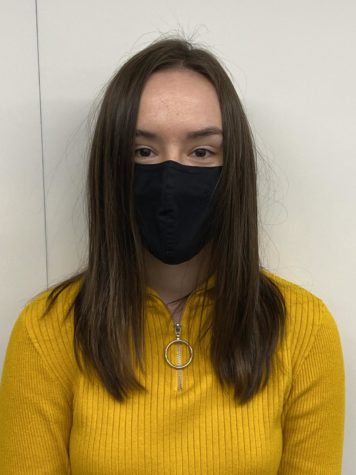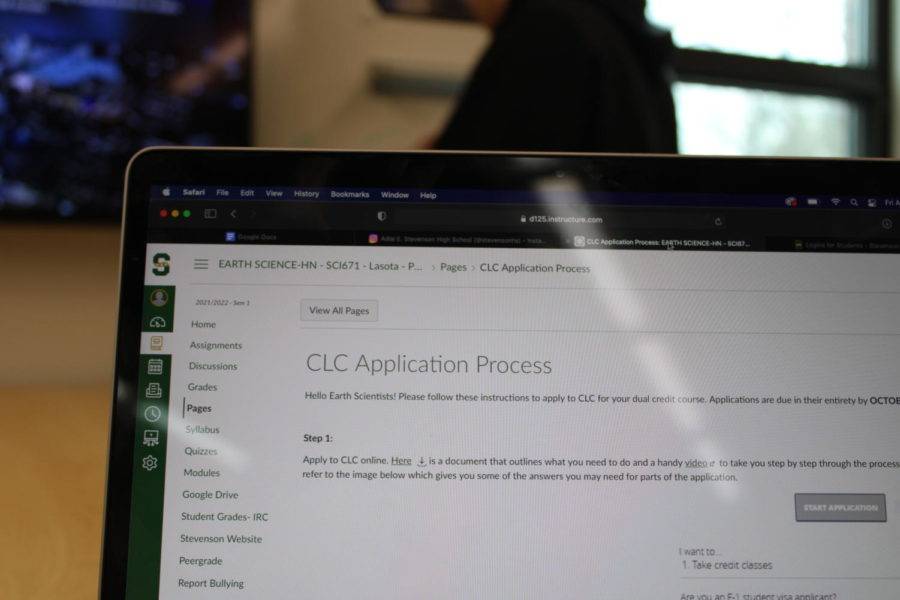Behind the Scenes of Dual Credit
Diving deeper into the details of dual credit, the advantages and why students should be aware of these courses
During the annual dual credit meeting for the College of Lake County (CLC) last month, Stevenson teacher Lauren LaSota looked on at the Zoom meeting, unaware her students had nominated her for an award. In the main session, an announcement was made, and LaSota was recognized as CLC’s dual credit teacher of the year in front of the over 100 people attending the meeting.
LaSota was the only instructor in the county who received the award for transfer-level, dual credit instructor. Having just started teaching dual credit Earth Science Honors last year, LaSota says she was honored to receive this award.
“It just helps me to feel so much more confident and then humbled by my students and by the impact I must’ve made,” LaSota said. “It was a lot of work, but it seems that it’s paid off and I’m proud of that.”
LaSota is one of many teachers at Stevenson who teach dual credit courses, the impact of which allows students to learn and grow through a college experience. Gianna Aragones ’22, who is taking Earth Science Honors, feels that dual credit courses offer students a unique opportunity to get a head start in their higher education.
“The biggest advantage is getting a college credit for the class you take, that way you can start your college transcript and get credit for college and high school for taking the class,” Aragones said.
While many students know about Advanced Placement (AP) courses, which give students an opportunity to take college-level courses, dual credit provides another kind of rigorous experience. AP courses award students credit as a result of scoring well on the AP exam, contrary to dual credit courses which award credit for doing well throughout the course.
“In terms of getting credit at your future university, it’s a lot more helpful to have dual credit because a lot more people can actually receive the credit,” dual credit student Srusti Donapati ’22 said. “The classes I took that were dual credit really went into deep elaboration on the topics that we were actually learning. And compared to an AP class, it felt a lot more like I was truly learning it and growing as a scholar rather than memorizing information with the hopes that I would get a certain score on an exam.”
According to Donapati, who has taken dual credit Sociology Honors and dual credit Philosophy Honors, dual credit courses allow for a more in-depth learning experience because they don’t stress the AP exam as an end goal. The extra time at the end of dual credit courses, which would have been spent on AP exam prep, is used for projects that allow for a deeper understanding of content.
“In my philosophy class, we used the extra time that we had at the end of the semester to find our own philosopher and really research their theories and do our own original presentation on it,” Donapati said. “I feel like this was more creative and a good use of time in terms of developing our own individual knowledge.”
Dual credit programs stem from high school partnerships with local colleges. Brigid Schultz, the original creator and founder of the dual credit program at Loyola University Chicago, helped spark the initial connection between high schools and Loyola—the first step at initiating a dual credit course.
“I’m pretty much the conduit between the high schools and the university faculty,” Schultz said. “I look for high schools to partner with, and then I work with my college faculty as well.”
Once the partnership is established, both the teacher and course must meet the criteria in order for the college to extend their accreditation. For example, teachers must have a masters degree in their content area, and the syllabus must align with the associated college course. Colleges like Loyola and CLC work closely in a collaborative environment with high schools like Stevenson to build these classes from scratch.
“We’ve put in a lot of pieces to ensure that when a student leaves high school with a class on a Loyola transcript that it means something, that it equates to the same rigor that we expect of our college students on campus,” Schultz said.
According to Schultz, when a student enters college with dual credits, a door of opportunities is opened for them. Having dual credit allows students to take more advanced courses in college, pursue electives that they’re interested in, and even graduate early.
“Research shows at the national level and at the state level that students who take dual credit classes while in high school are more successful in college than their peers who did not take dual credit in high school,” Sarah Stashkiw, the CLC Director for P-20 Educational Partnerships, said. “So it really is setting students up for success as they graduate high school and move on to college.”
Schultz says that students who participate in dual credit show up on campus their freshman year more confident that they can do well because they’ve already been immersed in a college class. Dual credit gives students a head start, because they know what to expect.
“You can check the box that says ‘I’ve taken a college course,’” dual credit Philosophy Honors teacher N. Clayton Duba said. “Not just a college level course, but an actual college course.”
When students enroll in a dual credit course, they are considered actual college students. According to Schultz, students can think of their dual credit high school classroom as a satellite campus of a college; they are in a real college class taught by a real college instructor doing rigorous college work.
“Once a student enrolls in a dual credit class, they’re CLC students and they’re part of our CLC community, so they have access to a lot of resources through the college,” Stashkiw said. “They can use our library facilities, in person or online. They have access to our P.E. center, they have access to the academic advisors at the college, so there are a lot of resources that CLC has to offer its students, and those are available to dual credit students as well.”
Both CLC and Loyola offer flexible drop dates in which students can choose to drop a dual credit course. Schultz says that the last thing colleges want is for students to have their first college transcript grade be a poor one, so students are able to drop the dual credit element of the course up until half way through the year. This provides a safety net for students while also allowing them to save both time and money.
“It speaks to why I love my job so much: it’s helping students and their families save incredible amounts of money and time,” Schultz said. “We have to acknowledge there’s a serious college debt crisis in this country and all universities are part of that crisis.”
Dual credit courses at Loyola cost $195 for a three credit hour course, and when compared to tuition costs at a typical four year university, the savings are multiplied. While Loyola dual credit courses cost money, CLC offers all of them for free.
“It’s very important for us as a college and as a department that dual credit is available to as many students as possible,” Stashkiw said. “CLC does waive tuition and fees for dual credit so it’s an opportunity for students not only to start on their college career early, but to do so for free. We don’t want dual credit to only be available to those who can pay for it.”
According to Stashkiw, based on the number of dual credit students this year, CLC expects to save students across the county over $1.5 million in just CLC tuition and fees alone. Once students transfer these credits to institutions that charge thousands of dollars per credit hour, students will save dramatically.
While dual credit is typically only available to juniors and seniors (and sophomores in some cases), the expansion of the dual credit program across the county has increased opportunities for high school students to pursue dual credit courses.
“School districts have really been stepping up and saying we want to offer these opportunities for students,” Juliann Abderholden, a CLC dual credit program coordinator, said. “That’s why our department is growing; that’s why dual credit programming in Lake County is growing. Everyone really wants to bring these opportunities to students.”
Schultz accredits the expansive opportunities in dual credit to community colleges like CLC. Schultz believes that without community colleges, dual credit would not be possible.
Both CLC and Loyola strive to provide students all the opportunities possible to get involved with dual credit, making collegiate level courses accessible to high school students across the county. Stashkiw highly encourages students to try dual credit and not overlook the value that dual credit can have on one’s learning.
“I think [dual credit] is such a great opportunity for students,” Stashkiw said. “So the more we can do to spread the word and expand these opportunities, the better it is for our county.”




LM | May 22, 2022 at 3:02 pm
Excellent article! Bravo!